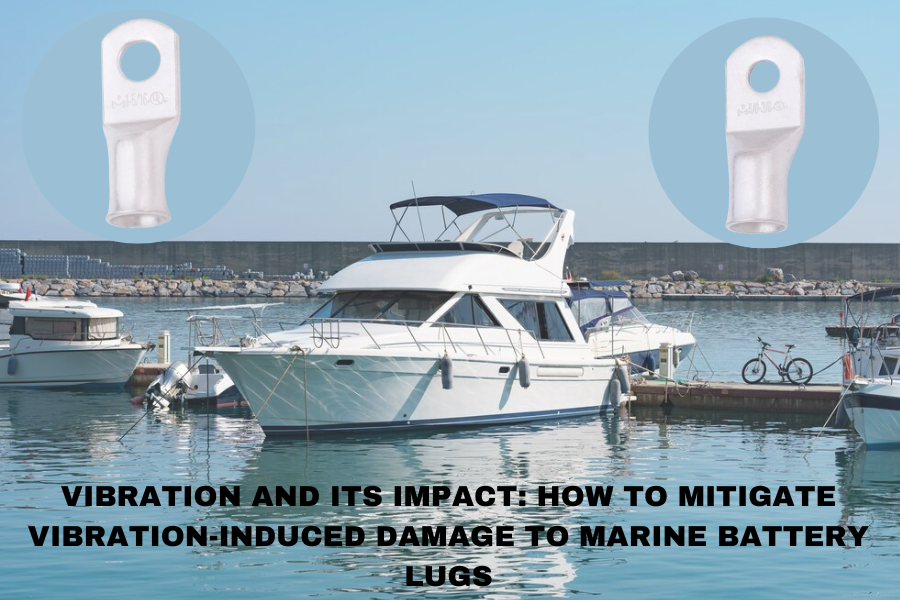In the demanding marine environment, battery systems are vital for the operation of a wide range of equipment, from navigation systems to communication devices. However, the constant exposure to vibrations from the engine, rough seas, and other operational activities can cause significant damage to Marine Battery Lugs. These vibrations can lead to loose connections, increased resistance, and ultimately, failure of the electrical system. Understanding the impact of vibration and implementing effective mitigation strategies is crucial to ensuring the longevity and reliability of marine battery systems.
Understanding Vibration and Its Impact
Vibration is a mechanical phenomenon where oscillations occur about an equilibrium point. In marine environments, vibrations are omnipresent due to various factors including engine operation, hull movements, and wave impacts. When these vibrations are transmitted to battery systems, they can cause several issues:
- Mechanical Fatigue: Continuous vibration can lead to mechanical fatigue of the battery lugs. This process involves the gradual weakening of the metal due to repeated stress cycles, which can eventually cause cracks and fractures.
- Loose Connections: Vibrations can loosen the connections between the battery lugs and the cables. Loose connections increase electrical resistance, which can lead to overheating, reduced efficiency, and potential fire hazards.
- Corrosion: The combination of vibrations and the harsh marine environment can accelerate the corrosion of Marine Battery Lugs. Corrosion weakens the metal, further contributing to mechanical failure.
- Electrical Failures: Increased resistance and intermittent connections caused by vibration can lead to erratic electrical performance. This can disrupt the operation of critical equipment and systems on board.
Strategies to Mitigate Vibration-Induced Damage
Mitigating the impact of vibrations on marine battery lugs involves a combination of design considerations, material selection, and maintenance practices. Here are some effective strategies:
-
Use of Vibration-Damping Materials
One of the most effective ways to reduce vibration-induced damage is by using materials that dampen vibrations. Rubber mounts, grommets, and vibration-damping pads can be placed between the battery and its mounting surface to absorb and dissipate vibrational energy. These materials can significantly reduce the transmission of vibrations to the battery lugs, thereby extending their lifespan.
-
Proper Battery Mounting
Ensuring that batteries are securely mounted is crucial in minimizing vibration-related issues. Battery mounts should be designed to provide a stable platform that minimizes movement. Using brackets and straps can help keep the batteries firmly in place, reducing the mechanical stress on the lugs. Additionally, mounting batteries on a solid, vibration-absorbing base can further enhance stability.
-
Regular Inspection and Maintenance
Regular inspection and maintenance of battery connections are essential to identify and address potential issues before they lead to failure. Checking for loose connections, signs of corrosion, and wear and tear on the lugs should be part of the routine maintenance schedule. Tightening loose connections and cleaning corroded terminals can prevent many vibration-induced problems.
-
Use of Flexible Cables
Flexible cables are more resistant to the effects of vibration compared to rigid cables. They can absorb and dissipate vibrational energy more effectively, reducing the stress on the battery lugs. Using high-quality, marine-grade flexible cables can significantly enhance the durability of the battery system.
-
Crimping and Soldering Techniques
Proper crimping and soldering techniques are critical to ensuring a secure and reliable connection between the battery lugs and the cables. Using the right tools and techniques can help create strong connections that are less susceptible to loosening due to vibrations. Additionally, applying heat-shrink tubing or other protective coatings can help protect the connections from corrosion and mechanical wear.
-
Environmental Protection
Protecting battery systems from the harsh marine environment can help mitigate vibration-induced damage. Enclosures and covers can shield batteries from direct exposure to water, salt, and other corrosive elements. Using anti-corrosion coatings on Marine Grade Battery Lugs and terminals can also extend their lifespan.
-
Monitoring Systems
Implementing monitoring systems that track the condition of the battery and its connections can provide early warning of potential issues. Voltage and current sensors can detect irregularities that may indicate loose connections or increased resistance. Early detection allows for timely maintenance and repairs, preventing more severe damage.
Conclusion
Vibration-induced damage to Marine Grade Battery Lugs is a significant concern that can impact the reliability and safety of marine electrical systems. By understanding the mechanisms of vibration damage and implementing effective mitigation strategies, it is possible to extend the lifespan of battery systems and ensure their reliable operation. Using vibration-damping materials, ensuring proper battery mounting, regular inspection and maintenance, using flexible cables, employing proper crimping and soldering techniques, protecting the environment, and utilizing monitoring systems are all key components of a comprehensive approach to mitigating vibration-induced damage. By taking these steps, marine operators can enhance the performance and safety of their battery systems, ultimately ensuring smoother and more reliable operations.









